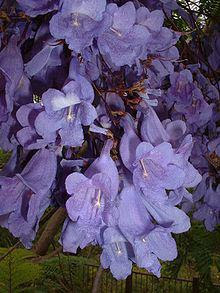Jacaranda acutifolia (NILI GULMOHAR) auct. non-Humb. & Bonpl.
Synonym J. mimosifolia D. Don J. ovalifolia R. Br.
Family Bignoniaceae.
Habitat Cultivated in Indian gardens.

Folk/UNANI : Nili-gulmohar.
Action Leaves’ volatile oil—applied to buboes. Leaves and bark of the plant—used for syphilis and blennorrhagia. An infusion of the bark is employed as a lotion for ulcers. The leaves contain jacaranone, verbascoside and phenylacetic-beta-glucoside along with a glucose ester, jacaranose.
Flavonoid scutellarein and its -glucuronide, and hydroquinones were also isolated. Fruits contain betasitosterol, ursolic acid and hentriacontane; stem bark gave lupenone and beta-sitosterol. The flowers contain an anthocyanin. In Pakistan, the flowers are sold as a substitute for the Unani herb Gul-e- Gaozabaan. The lyophylized aqueous extract of
the stem showed a high and broad antimicrobial activity against human
urinary tract bacteria, especially Pseudomonas sp. The fatty acid, jacarandic acid, isolated from the seed oil, was found to
be a strong inhibitor of prostaglandin biosynthesis in sheep.
J. rhombifolia G. F. W. May., syn.
J. filicifolia D. Don is grown in Indian
gardens. Extracts of the plant show insecticidal properties. Several species of Jacaranda are used for syphilis in Brazil and other parts of South America under the names carobin, carabinha etc. A crystalline substance, carobin, besides resins, acids and caroba balsam, has been isolated from them.